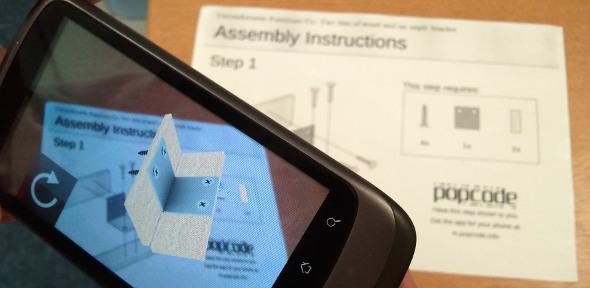
Have you ever struggled to follow a set of assembly instructions for flat-pack furniture? Simon Taylor, a PhD student in the Computer Vision group in the Machine Intelligence laboratory, and Connell Gauld, a graduate of the MEng course in 2010, have been working on a framework for adding virtual content to real world objects. They can bring written instructions to life using a technique called Augmented Reality (AR).
Augmented Reality has been a key research interest in Dr Tom Drummond's (a former member of the Computer Vision and Robotics) group for over 10 years. Recent advances in the performance of mobile phones along with continued development of computer vision techniques now make it possible for engaging AR content to be delivered straight into the hands of users.
Tom, Simon and Connell formed Extra Reality Limited in June 2010 in order to pursue commercialisation of the technology. Their first product is called Popcode. They released the first version of their Popcode application and a free Developer Kit at the end of August 2010. Popcode is a logo that when scanned with a mobile phone allows 3D models, animations, and interactive elements to be added to any textured flat surface. Unlike some existing "AR Browsers" that use GPS to provide the rough position of the phone, Popcode uses computer vision techniques developed during Simon's PhD to accurately calculate the position of the phone relative to the target surface. This more accurate position information can lead to more engaging and believable AR applications.
Objects with AR content are identified with the small "Popcode" logo which contains a unique ID for the content. When the application recognises the Popcode it will downloaded the related content from the Internet and display it to the user. Connell's 4th Year Masters project looked at the method for embedding an identifier into a logo and the language used for describing the content, and this work has been directly incorporated into Popcode.
A recent demonstration put together by the team shows how Popcode can help to make assembly instructions for flat-pack furniture more understandable by showing the exact steps required in 3D.
The Popcode website at http://www.popcode.info shows some other possible uses of the platform. Some of the ideas include augmented business cards that can be updated over the internet and adding interactivity to static maps such as those displayed in cities.
Simon says "Although we've put together a few pieces of content ourselves to give some ideas about what is possible, we're really interested to see what uses other people will think of for the technology. The Developer Kit http://www.popcode.info/developers contains examples and documentation so developers can get started working with Popcode, and we'll be happy to help out with any problems people come across through our forums."
The team are continuing to work on improving the performance and capabilities of Popcode, as well as making the application available on more mobile phones.

